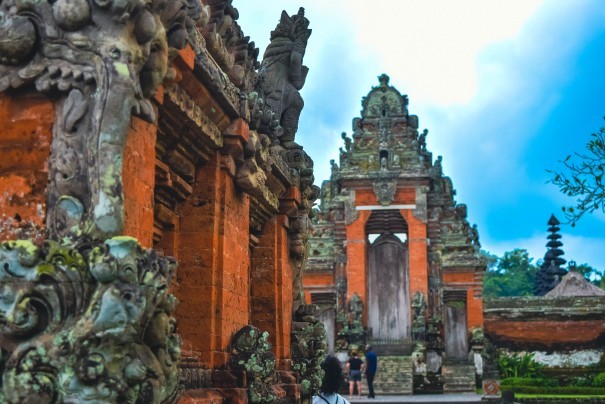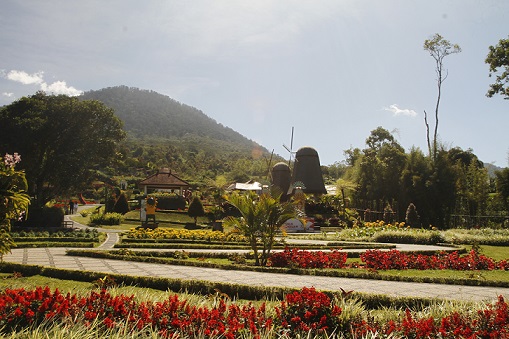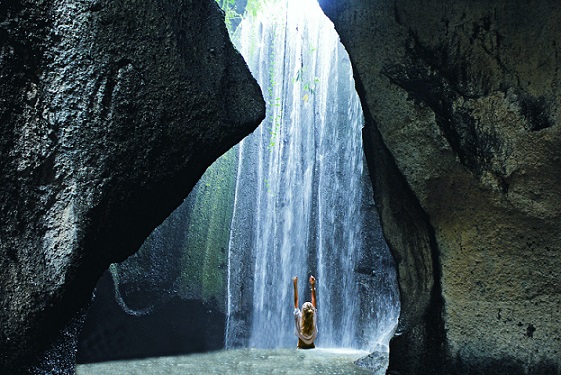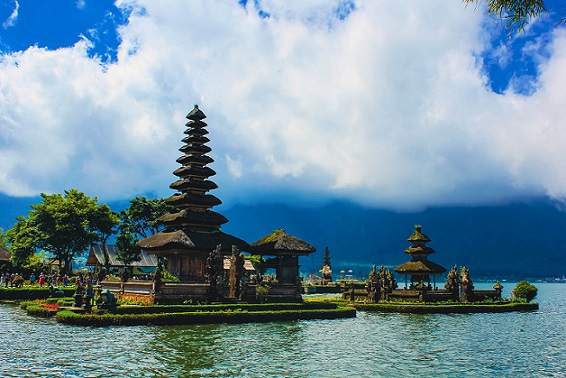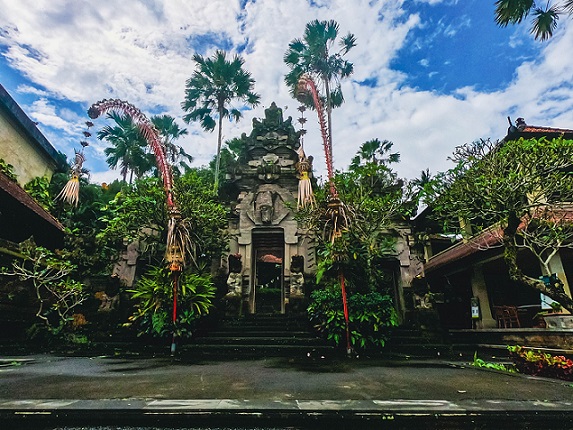Exploring the Spiritual Majesty of Taman Ayun – Nestled in the heart of Bali, away from the bustling tourist hotspots, lies Mengwi Temple – Taman Ayun Temple, a site steeped in spiritual significance and architectural beauty. Officially known as Pura Taman Ayun, this temple is not just a religious site but a breathtaking monument to Bali’s rich cultural heritage.
My journey to Mengwi Temple was driven by a desire to connect with the quieter, more spiritual side of Bali—an aspect often overshadowed by its beaches and party scenes. As I approached the temple grounds, the serene atmosphere and the intricate carvings on the temple gates hinted at the historical depth and artistic mastery awaiting inside.
This remarkable temple complex, once the royal temple of the Mengwi Empire, serves not only as a place of worship but also as a symbol of the harmonious relationship between nature, humanity, and the divine. Built in the 17th century, its lush gardens, expansive fish ponds, and towering pagodas create a picturesque setting that captivates the eye and calms the soul.
Join me as we delve deeper into the history, architecture, and spiritual allure of Mengwi Temple, discovering the echoes of the past and the timeless beauty that this unique temple continues to preserve.
History and Significance of Mengwi Temple: A Cultural Tapestry

Mengwi Temple, or Pura Taman Ayun as it is locally known, is more than just an architectural marvel; it’s a deeply spiritual place that holds a special place in the heart of Balinese culture. Established in the mid-17th century by the then ruler of the Mengwi kingdom, I Gusti Agung Putu, this temple is a historical testament to Bali’s age-old regal and religious traditions.
Architectural Grandeur
The temple’s design reflects the traditional Balinese concept of “Tri Hita Karana”, which embodies the idea of a harmonious relationship between the human, spiritual, and environmental realms. The complex is surrounded by a wide moat, suggesting that it was intended as a place of sanctity and purification, symbolizing a spiritual journey that separates the mundane world from the sacred space of the gods.
The layout of Pura Taman Ayun is a fine example of Balinese architectural principles, featuring a forecourt, a central court, and a sanctum. The intricately carved gates between these areas are not merely decorative but serve as symbolic thresholds between the worldly and the divine.
Cultural and Religious Significance
Historically, Mengwi Temple served as the main site of worship for the Mengwi royalty, a place where rituals and ceremonies could connect the mundane with the divine. Today, it stands as a vital link to the past, continuing to host important religious ceremonies and festivals that draw participants from across the island. These events are not only a spectacle for tourists but are a living part of Balinese Hinduism, reflecting the community’s strong ties to their religious and cultural traditions.
The temple is also famous for its expansive gardens and beautiful water features, which are believed to be representative of the spiritual world, with the lotus-covered ponds symbolizing purity and the cosmic ocean.
UNESCO Recognition
Adding to its prestige, Pura Taman Ayun is recognized as part of Bali’s UNESCO World Heritage Cultural Landscape, which includes the island’s five preeminent rice terraces and their water temples. The inclusion of Mengwi Temple in this list underscores its importance not only as a spiritual and cultural center but also as an example of sustainable traditional agricultural practices, which have been preserved over centuries.
You may also like : Bali Affordable Tours and Destination
Best Way To Getting There

Mengwi Temple, also known as Pura Taman Ayun, is located in Mengwi Village, approximately 18 kilometers northwest of Denpasar, Bali. The temple is easily accessible by car or motorbike, and the roads leading to it are well-maintained. If you’re staying in popular areas like Kuta or Seminyak, the drive can take around 45 minutes, depending on traffic. Public transportation options are limited, so hiring a taxi or renting a scooter might be your best bet.
Best Time to Visit
The best time to visit Mengwi Temple is during the early morning or late afternoon when the temperatures are cooler and the light is ideal for photography. These times also tend to be less crowded. If you can, try to visit during a local religious ceremony, which will offer a deeper insight into Balinese culture and religious practices. However, be respectful and ensure you do not intrude on these sacred rituals.
Entry Fees and Opening Hours
Mengwi Temple is open to visitors every day from 8:00 AM to 5:00 PM. There is a modest entry fee of approximately 30,000 IDR (about 2 USD), which helps with the maintenance and preservation of the temple grounds. Guides are available for hire at the entrance if you wish to have a detailed tour and learn more about the history and cultural significance of the site.
Local Transportation
If you’re not comfortable driving in Bali, consider booking a tour that includes Mengwi Temple along with other nearby attractions. Many local travel agencies offer half-day or full-day tours at reasonable prices. This not only eases transportation concerns but also provides enriching information through knowledgeable guides.
Tips for Visitors
- Dress respectfully, as Mengwi Temple is a religious site. This means wearing clothing that covers your shoulders and knees. Sarongs are available for rent at the entrance if needed.
- It’s advisable to bring a hat and sunscreen, as the midday sun can get quite intense, and much of the temple is exposed.
- Make sure to bring your camera, as the temple and its surroundings are incredibly picturesque.
- Be aware of the local customs and traditions. For example, it’s considered disrespectful to point your feet at the shrines or touch the religious artifacts.
SPOT RECOMMENDATION!
- Mengwi Temple, Bali Monkey Forest, and Tanah Lot Tour
- Explore Bedugul and Tanah Lot Sunset Temple
- Lempuyang Temple, The Gate of Heaven Tour
- Balinese Water Purifying Tour at Water Temple
Reflecting on a Journey Through Time at Mengwi Temple

As my day at Mengwi Temple drew to a close, I found myself lingering by the tranquil waters of the surrounding moat, reluctant to leave this place of serene beauty and profound peace. The temple’s majestic structures and detailed carvings seemed to narrate stories of a rich past, whispering secrets of the Balinese culture and spirituality that have been preserved over centuries.
Visiting Pura Taman Ayun isn’t just a touristic activity; it’s a pilgrimage into the heart of Bali’s royal history and religious devotion. Each corner of the temple grounds offers a moment of reflection, inviting one to appreciate not only the artistic and architectural achievements but also the deep spiritual roots that define Bali’s identity.
This temple, with its ornate pagodas and expansive gardens, stands as a testament to the island’s enduring charm and the timeless relevance of its traditions. It’s a reminder of the beauty that arises when nature, culture, and spirituality weave together to create something truly transcendent.
Call to Action: Engage and Connect
Did this glimpse into Mengwi Temple inspire you to explore more of Bali’s hidden gems? If so, I encourage you to share your thoughts and experiences in the comments below. Perhaps you’ve visited Mengwi Temple yourself and have a story to tell, or maybe you’re planning your journey and have questions about this enchanting place.
For more stories like this, make sure to subscribe to our newsletter and follow us on social media, where we share more of our adventures and insights from around the globe. Your engagement helps us grow and continue to bring you the best of world travel. Ready to see more? Check out our other posts on Bali’s cultural sites and start planning your next adventure today!
You may also like : Bali Destination News Update


